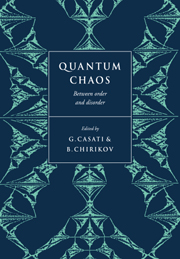Book contents
- Frontmatter
- Contents
- Preface
- Acknowledgments
- Introduction
- Part One Classical chaos and quantum localization
- Stochastic behaviour of a quantum pendulum under a periodic perturbation
- Quantum dynamics of a nonintegrable system
- Excitation of molecular rotation by periodic microwave pulses. A testing ground for Anderson localization
- Localization of diffusive excitation in multi-level systems
- Classical and quantum chaos for a kicked top
- Self-similarity in quantum dynamics
- Time irreversibility of classically chaotic quantum dynamics
- Effect of noise on time-dependent quantum chaos
- Dynamical localization, dissipation and noise
- Maximum entropy models and quantum transmssion in disordered systems
- Solid state “atoms” in intense oscillating fields
- Part Two Atoms in strong fields
- Part Three Semiclassical approximations
- Part Four Level statistics and random matrix theory
- Index
Quantum dynamics of a nonintegrable system
Published online by Cambridge University Press: 07 May 2010
- Frontmatter
- Contents
- Preface
- Acknowledgments
- Introduction
- Part One Classical chaos and quantum localization
- Stochastic behaviour of a quantum pendulum under a periodic perturbation
- Quantum dynamics of a nonintegrable system
- Excitation of molecular rotation by periodic microwave pulses. A testing ground for Anderson localization
- Localization of diffusive excitation in multi-level systems
- Classical and quantum chaos for a kicked top
- Self-similarity in quantum dynamics
- Time irreversibility of classically chaotic quantum dynamics
- Effect of noise on time-dependent quantum chaos
- Dynamical localization, dissipation and noise
- Maximum entropy models and quantum transmssion in disordered systems
- Solid state “atoms” in intense oscillating fields
- Part Two Atoms in strong fields
- Part Three Semiclassical approximations
- Part Four Level statistics and random matrix theory
- Index
Summary
The quantum motion of a periodically kicked rotator is shown to be related to Anderson's problem of motion of a quantum particle in a one-dimensional lattice in the presence of a static-random potential. Classically, the first problem is nonintegrable and, for certain values of the parameters, exhibits chaos and diffusion in phase space; in the second problem, diffusion takes place in configuration space. Quantum phase interference, however, is known to suppress diffusion in Anderson's problem and to produce quasiperiodic motion. By establishing a mapping between the two systems we show that a similar effect determines the dynamics of the quantum rotator. As a result its wave functions are localized in phase space and their time evolution is quasiperiodic. This result explains the quantum recurrences and boundedness of the energy found in recent numerical work.
INTRODUCTION
In recent years the study of the effects of quantization on the properties of classically nonintegrable systems has attracted increasing attention. The understanding of the nature of quantum behavior of these systems is not only of fundamental importance but it is also a problem of experimental relevance in fields as diverse as photochemistry, electron dynamics in microstructures, and other contexts. Understanding the relation between quantum problems and their classical limit may also shed light on the zero wavelength approximation to other wave equations, for example the eikonal approximation to the magnetohydrodynamic equations that are of great interest in plasma physics. In the context of applications to photochemistry various model systems described by timeindependent Hamiltonians have been recently studied.
- Type
- Chapter
- Information
- Quantum ChaosBetween Order and Disorder, pp. 77 - 86Publisher: Cambridge University PressPrint publication year: 1995

